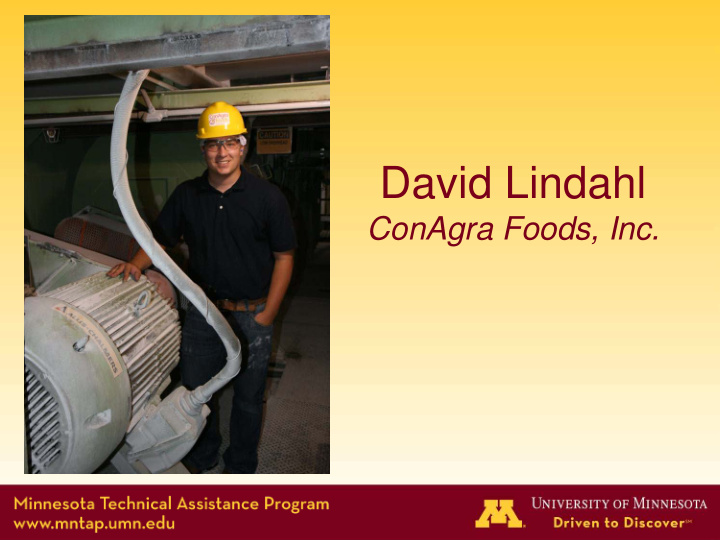



David Lindahl ConAgra Foods, Inc.
Energy Efficiency at a Flour Mill ConAgra Foods David Lindahl Advisor: AJ Van den Berghe
Company Overview • Leader in Commercial and Consumer food products • Hastings Mill - Wheat flour and food products - Sold in commercial sized bags and bulk to consumer food processing companies
Hastings Mill
Motivations for Change • Cost savings from efficiency improvements • Delivers information to drive improvement • Advances company goal for continuous improvement
Reasons for MnTAP Assistance • Achieve a 2.5% reduction in energy consumption • Make energy management easier
Power Use Model • Objectives – Predict energy use for certain mill and pack output – Report and discuss days of high or low energy at Review & Response meetings – Use abnormalities to identify root cause and find solutions. – Measures effectiveness of solutions kWh = Kj*(Mill cwt output)+ Ki*(Pack bags)+ Ko
Actual vs. Predicted Energy Use Energy (kWh) Energy Use kWh Predicted Energy Use Model Accuracy R Squared: .982 Time
Approach Correct Fix and Replace Energy Tune Behaviors
Determining Inefficient Processes • Observed Energy Saving Opportunities – Compressed air – Lighting overuse – Incomplete shutdown – Conveyors
Determining Inefficient Processes • Took baseline measurements to find current system efficiencies • Voltage • Amperage • Flow rates • Static Pressures
Energy Behavioral Training • Background – Energy Awareness – Knowledge of cost • Problem – Inefficient energy practices
Energy Behavioral Training • Solution – Change Culture – Educate – Verify follow through
Vacuum System • Background – 4 vacuum systems (200hp total) – Mill Sanitation
Vacuum System • Why is it a problem? – Continuous operation – 2nd and 3rd shift demand – Simplicity for operators • Solution – Remotely-accessible, on-demand system – 3 month payback
Filtration System • Background – Bag Filters – Air makeup – General suction
Filtration System • Why is it a problem? – Sock cleaning pulse rate control – Dirty socks compared to clean socks – Flow rate effects
Filtration System • Solution 1 - Control sock pulse - Delta P control - Sock life - Compressed air savings
Filtration System • Solution 2 – Airflow Controller – Controls fan speed based on pressure differential – Designed flow rate
Lighting • Background – High bay fixtures are Class 2 Division 2 – Group G for combustible grain dust – High-intensity discharge (HID) metal halide lamps
Lighting • Why is it a problem? – Inefficient metal halide lamps – Low quality of light – Low bulb life – Lumen loss (45% MH, 6% fluorescents) – Excessive use
Lighting • Solution 1 - Retrofit with T5 High Output (HO) - Quick start - 13 Watts less /fixture - 4,000 more lumens /fixture - 29 year payback
Lighting • Solution 2 - Occupancy Sensors (non production areas) - Simple solution - Rebates make them economical (10 month payback)
Successful Process Changes • 1,030 MWh feasible savings so far • 1.87 million lbs CO2 savings • $66,890 in energy savings identified • More opportunity with continued study
Recommendations Overview Waste reduction Waste reduced Cost savings Cost Payback period option (per year) (per year) Occupancy Sensor 71,100 kWh $3,950 $4,622 10 months Installation Energy Behavioral and Procedural 223,190 kWh $0 $14,580 Immediate Training Program Vacuum System 735,000 kWh $14,000 $48,800 3 months Automation Sock Clean Delta P $1,100 per unit more study needed Control Bag Filter Airflow more study needed Controller System
Personal Benefits • Gained project management skills • Grew personally and professionally • Felt success • Trip to ConAgra corporate headquarters
Recommend
More recommend